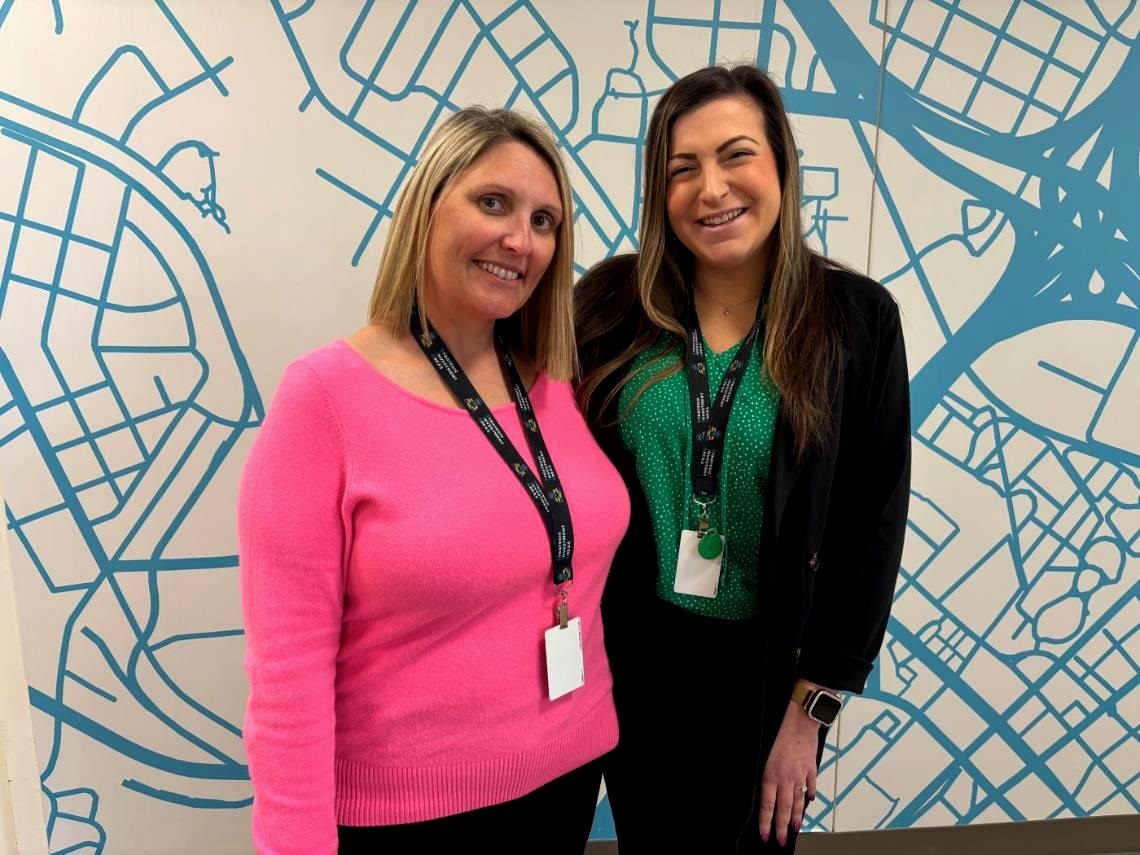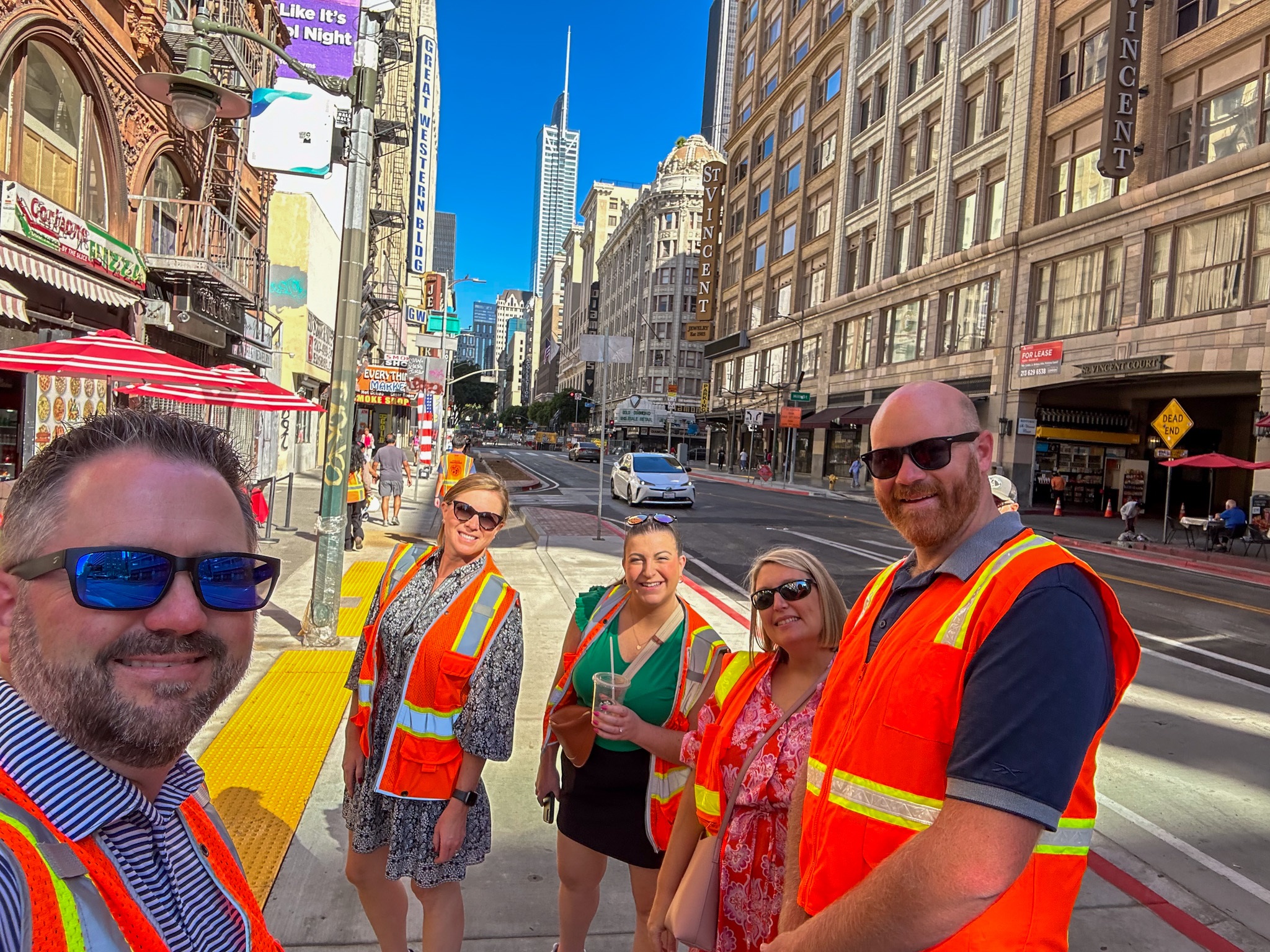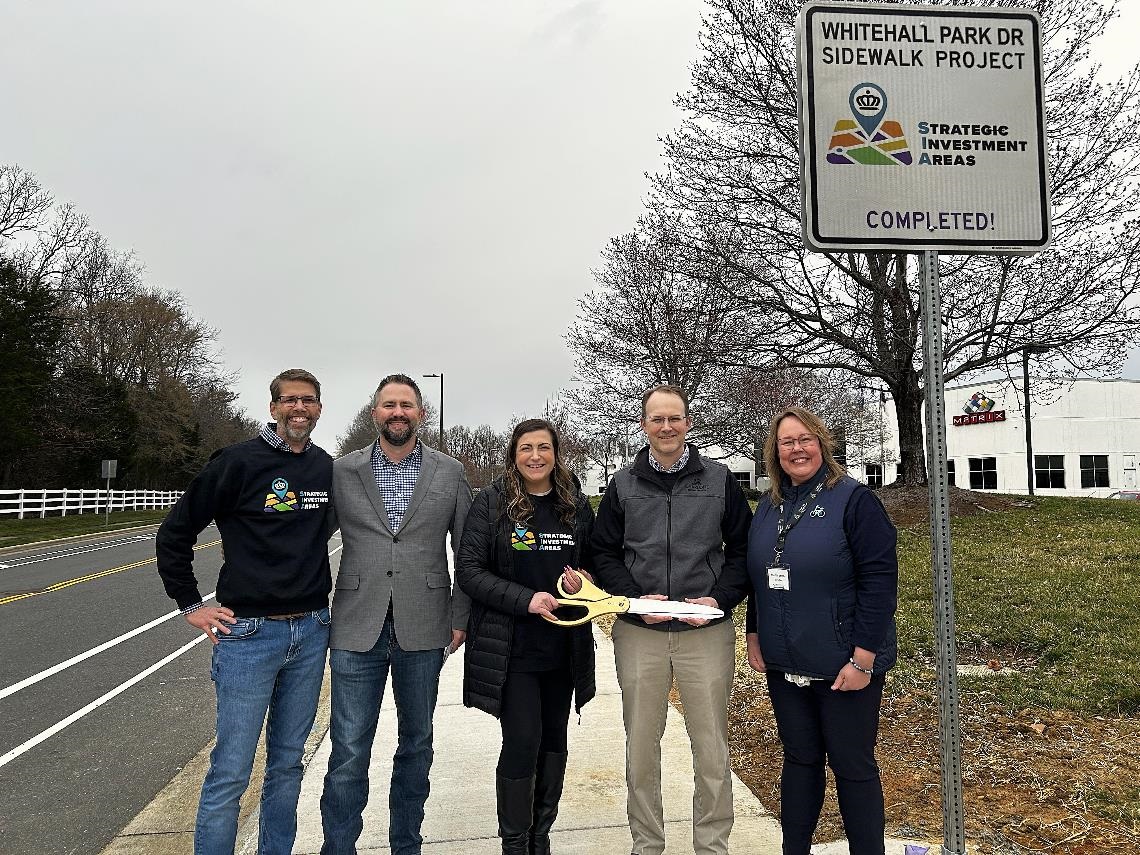The Women Moving Charlotte's Mobility Forward
Published on March 25, 2025

Ashley Landis (left) and Mackenzie Nowacki (right) are the two co-leads of the city's SIA program.
By Morgan Newell
How do you define mobility in a city growing as fast as Charlotte? The dictionary definition is the movement of people and goods through different means of transportation. The mind tends to go to cars, buses, and trains. However, it’s so much more. Mobility means sidewalks and walking paths, like the Rail Trail. It means cycling in bike lanes that are wide enough to keep cyclists safe. It means better roads and less traffic.
Mobility can also mean connection. It is the ability to get between your house and your friend’s within a reasonable timeframe. It’s the walk to the coffee shop, where the barista knows your name. It’s a packed car on the Blue Line full of hopeful Charlotte FC fans ready for a lively game.
Mobility is movement, and all this movement takes planning, infrastructure, and a whole lot of math. At the City of Charlotte, two women are at the forefront of shaping how residents move. Planning and Design Deputy Division Manager Ashley Landis and Engineering Program Manager Mackenzie Nowacki are driving the city’s mobility forward as co-leads of the Strategic Investment Areas (SIA) program—a groundbreaking effort to improve transportation infrastructure through data-driven projects. With a combined passion for engineering, planning, and problem-solving, Landis and Nowacki are tackling this program head-on and breaking barriers in a traditionally male-dominated field.
Different Paths Toward a Shared Passion
The women behind one of the city’s biggest mobility projects got to this point in their careers in quite different ways.
For Nowacki, engineering was always the plan.
“I was always good at math and science, and I had uncles who were civil engineers,” she said.
Since engineering ran in the family, Nowacki grew up around it. She said her uncles showed her what a career path with civil engineering could look like at a very early age. However, the only person standing in the way of Nowacki was herself. She admitted her rebellious teen phase almost took her down a path to being a business major. It was her extended family that set her straight.
“My uncles sat me down and told me I needed to switch my major to something that would help me with engineering,” Nowacki recalled. “So, right when I got to college, I had to go and switch my major.”
Landis, on the other hand, discovered her passion unexpectedly. Coming from a family of teachers, she thought that was her path. Until she realized it wasn’t.
“In college, I had friends studying engineering, and I would help them with math homework, specifically calculus,” she remembered.
Realizing how much fun she had with her friend’s assignments, she added a general engineering class to her schedule. Landis liked the class and loved the geometry homework that came with it. It wasn’t until a transportation engineer came as a guest speaker she found her passion.
“I was immediately drawn in,” Landis remarked. “I knew I wanted to work with geometry and design every day.”
Civil Engineering: A Male-Dominated Field

Landis and Nowacki on a Peer City exchange trip in Los Angeles
As Landis and Nowacki continued their education, they did share one thing in common–they were both one of a handful of women in any college classroom.
“I remember sitting in an auditorium with about 100 people and counting only eight women,” Nowacki explained.
Landis’ classroom experience mirrored her counterpart.
“There were maybe four or five of us in a room of 100,” she said. “It never really bothered me, but it was noticeable.”
Their experiences in the private sector also shaped their perspectives. Both shared a similar story of male-centered offices where leadership oftentimes didn’t look like them.
“The private sector was a wake-up call,” Nowacki admitted. “I could tell you horror stories about being a female in that culture early on.”
This didn’t stop them. Transitioning to the public sector and the City of Charlotte has opened their eyes to a different picture. They look around the room and see more women in leadership positions than they’ve ever seen. Plus, when it comes to picking people for their own teams, they appreciated the ability to hire other women wanting to break through the barriers of civil engineering.
“It is empowering to see how women can be in positions of power here at the city,” Nowacki noted.
Now, as the co-leads to the SIA project, they set the tone for what women can do when given the space and opportunity to lead.
The Strategic Investment Areas Program

Part of the SIA team at the Whitehall Park Drive Sidewalk Project ribbon cutting.
So, what exactly is this program that these two are leading? The Charlotte City Council adopted the Strategic Mobility Plan almost three years ago. The goal of this plan is safe, connected, and equitable mobility. The Strategic Mobility Plan is a macro view of what our mobility could look like in years to come. The Strategic Investment Areas (SIA) program turns that plan into action by using data to identify priority areas where mobility is already a challenge.
The city’s mobility needs exceeded our resources. The SIAs are places where the resources will have the greatest impact. The city used eight criteria for better mobility: Safety (High Injury Network), Pedestrian (Sidewalk Infeasibility), Complete Streets (No Curb and Gutter), Congestion (High Congestion Intersections), Transit (Bus Priority Corridors), Bicycle (Bicycle Priority Network), Growth (Activity Centers) and Equity (Transportation Disadvantaged Index). To become a SIA, a neighborhood needed to check off three or more. The city identified 22 SIAs following this guideline.
The SIA team knew where to direct their attention and were eager to get to work. Unfortunately, all 22 couldn’t be done at once—a least not without a plan anyway. That’s where Landis and Nowacki come in. They are at the forefront of a pilot program working to deliver expedited, impactful mobility projects. The pair work on two SIAs, Far East-Harrisburg and Arrowood, and evaluate how well projects work and what processes can be improved. This pilot program will be turned into a blueprint for how the city advances future mobility projects.
“It is so exciting being empowered to make decisions,” Landis said. “It isn’t something you walk out at 5 o’clock and stop thinking about. I think about who I can bring to the table and how I can do things differently all the time.”
“It is a unique, incredibly rewarding experience,” Nowacki beamed. “It’s not every day you have a leadership role and lift a program from the ground up.”
The duo went from knowing of each other, and occasionally working together on smaller projects, to being tapped for this pilot program. However, when asked what their greatest accomplishment is, they both looked at each other and agreed almost in unison—it’s SIA.
“The path is unblazed,” Landis declared. “We’re trailblazers.”
Advice for the Next Generation of Women in Engineering

Mackenzie Nowacki (left) and Ashley Landis (right) at the Harrisburg Road Sidewalk Project
For women considering careers in engineering, Landis and Nowacki had words of encouragement. Landis advocated for women to join the engineering workforce if they are good at science and math. She added that this job keeps it fresh because no two projects are ever the same. Nowacki vocalized doing something you love because the sky is the limit there. She mentioned finding a place where the leadership makes you want to work there.
They summed up all their words with one simple message: find your champion and be one yourself.
“Whether it’s a male or female mentor, lean on them. It’s easy to get discouraged, but having someone to support you makes all the difference,” Nowacki emphasized.
“Gender doesn’t define what you are capable of and where you’ll go, so don’t let it,” Landis said.
Ashley Landis and Mackenzie Nowacki aren’t just shaping Charlotte’s streets, railways, and neighborhoods; they are redefining what leadership looks like in engineering. Their work will leave a lasting impact, not just on mobility within our city, but also in keeping the door open for the women who will come behind them and make the words “male-dominated field” a thing of the past.
This article only touches on some of the work Landis, Nowacki, and their teams are doing. We invite you to learn more about the Strategic Investment Areas program and the city’s mobility future on our on our Strategic Mobility Plan page and in Volume 2: Our Approach – Strategic Investment Areas blueprint.